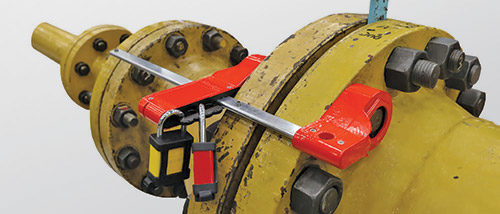Understanding blind-flange lockout devices
Because OSHA already considers a blind or blanking plate to be a lockout, how is the blind-flange lockout device a safety improvement?

Responding is Todd Grover, global senior manager for applied safety solutions, Master Lock Co., Oak Creek, WI.
OSHA’s long-standing lockout regulation to control hazardous energy sources originally identified blank flanges and bolted slip blinds as lockout devices under OSHA 29 CFR 1910.147(b) Definitions. The rationale was based on blank flanges and bolted slip blinds requiring at least as much effort to remove as locks. The removal of blanks or blinds requires wrenches to disassemble the nuts and bolts holding them in place, and using these tools is comparable to using bolt cutters to remove a lock.
However, a lock signals active personal participation and prohibits removal, except by the individual who applied it. Anyone who has the right-sized wrench can remove bolts securing blanks or blinds. Unfortunately, a number of incidents have been caused by the premature removal of blanks or blinds from piping systems.
Tags, when placed on blanks or blinds, provide only a general warning. OSHA has indicated that if tags are used to mark blanks or blinds, a method must be devised that clearly identifies each participant. For example, each authorized employee hangs a tag on the blank or blind when starting work and removes it when stopping work. However, experience shows that workers frequently do not take this step, or forget to remove their tags when work is complete, negating the dependability of this approach. This is also how incidents can happen.
Remember, OSHA has been very clear: If an isolation point can be locked out, it should be locked out. Lockout should be the primary means of protecting authorized personnel during work when unexpected flows of energy could cause harm. The ANSI Z244.1 Lockout/Tagout Standard also supports the prioritization of lockout as the preferred protective practice.
Fortunately, the ability to apply a well-designed manufactured device to just about any industrial energy isolation point has improved remarkably since the implementation of lockout regulation.
The blind-flange lockout device is a safety improvement. Its intention is to eliminate the opportunity for all bolts to be removed, helping to ensure the blank or blind remains in place to prevent premature releases of energy downstream or the release of a chemical into the environment.
It comes down to this protective method: The crew securing the pipeline locks-out upstream valves and then places a blank or blind in the system to positively block any potential downstream flow. The flange bolts are then torqued to proper specification. At least one of the torqued bolts is covered with the blind-flange lockout device. The device is then secured with one or more personal safety locks, or a group lockbox could be used. Multiple bolts could be covered using multiple devices, if desired.
Even with the necessary wrenches, the covered, torqued bolt that fastens the blank or blind tightly in place cannot be removed until the lockout device is properly unlocked and taken off when the work is completed.
This lockout method, using the blind-flange lockout device, adds a significant amount of protection for workers.
Editor's note: This article represents the independent views of the author and should not be construed as a National Safety Council endorsement.
Post a comment to this article
Safety+Health welcomes comments that promote respectful dialogue. Please stay on topic. Comments that contain personal attacks, profanity or abusive language – or those aggressively promoting products or services – will be removed. We reserve the right to determine which comments violate our comment policy. (Anonymous comments are welcome; merely skip the “name” field in the comment box. An email address is required but will not be included with your comment.)

